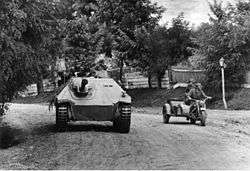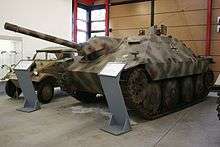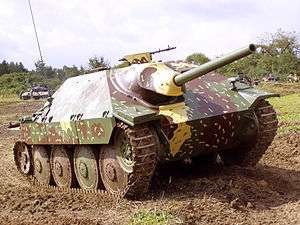Hetzer
| Jagdpanzer 38 | |
|---|---|
|
Jagdpanzer 38 in museum at Lešany, Czech Republic | |
| Type | Light tank destroyer |
| Place of origin | Nazi Germany |
| Service history | |
| In service | 1944–1945 |
| Used by |
Nazi Germany Hungary Czechoslovakia (ST-I) Switzerland (G-13) |
| Wars | World War II |
| Production history | |
| Designer | BMM |
| Designed | 1943 |
| Manufacturer | Böhmisch-Mährische Maschinenfabrik, Škoda |
| Produced | 4 March 1944 – 11 May 1945 |
| Number built | Approx. 2,827 |
| Variants | See Variants |
| Specifications | |
| Weight | 15.75 tonnes (34,722 lb) |
| Length | 6.38 m (20 ft 11 in) |
| Width | 2.63 m (8 ft 8 in) |
| Height | 2.17 m (7 ft 1 in) |
| Crew | 4 |
|
| |
| Armor | 8-60 mm (0.31-2.36 in) |
Main armament |
1x 7.5 cm Pak 39 L/48 41 rounds |
Secondary armament |
1× 7.92 mm Maschinengewehr 34 1,200 rounds |
| Engine |
Praga 6-cylinder petrol, 7.8 litres 160 PS (158 hp, 118 kW) at 2,800 rpm |
| Power/weight | 10.2 PS (7.5 kW) / tonne |
| Transmission | 5 + 1 Praga-Wilson Typ CV |
| Suspension | leaf spring |
| Ground clearance | 40 cm (1 ft 4 in) |
| Fuel capacity | 320 litres (85 US gal) |
Operational range | 177 km (110 mi) |
| Speed | 42 km/h (26 mph) |
The Jagdpanzer 38 (Sd.Kfz. 138/2), later known as Hetzer ("pursuer/hunter"), was a German light tank destroyer of the Second World War based on a modified Czechoslovakian Panzer 38(t) chassis. The project was inspired by the Romanian "Mareşal" tank destroyer.[1][2][3]
Name
The name Hetzer was at the time not commonly used for this vehicle. It was the designation for a related prototype, the E-10. The Škoda factory for a very short period confused the two names in its documentation and the very first unit equipped with the vehicle thus for a few weeks applied the incorrect name until matters were clarified. However, there exists a briefing paper from Heinz Guderian to Hitler claiming that an unofficial name, Hetzer, had spontaneously been coined by the troops. Post-war historians basing themselves on this statement made the name popular in their works, though the vehicle was never named as such in official documents.[4]
Development
The Jagdpanzer 38 was intended to be more cost-effective than the much more ambitious Jagdpanther and Jagdtiger designs of the same period. Using a proven chassis, it avoided the mechanical problems of the larger armoured vehicles.
It was built on the Panzerkampfwagen 38(t)'s widened and lengthened chassis with modified suspension (larger road-wheels from Praga TNH n.A prototype reconnaissance tank) and up-rated engine. The new engine was 160 PS Praga AC/2 6-cylinder engine controlled by Praga-Wilson gearbox (5 forward and 1 reverse gear). The chassis was modified in order to accommodate a larger gun and thicker armour than the regular Panzerkampfwagen 38(t) tank. Its combat weight was 16 metric tons (versus 9.8-tonnes for the Pz 38(t)) and it could travel at a maximum speed of 42 km/h.
It was better armored than the thinly armoured earlier Panzerjäger Marder and Nashorn with a sloped armour front plate of 60 mm sloped back at 60 degrees from the vertical (equivalent in protection to about 120 mm), carried a reasonably powerful 75 mm gun, was mechanically reliable, small and easily concealed. It was also cheap to build.
The Jagdpanzer 38 succeeded the open-top Marder III (based on the same chassis). In production from April 1944; about 2584 were built until the end of the war. The older Marder III Panzerjäger series retained the same vertically sided chassis as Panzer 38(t). In the Jagdpanzer 38, the lower hull sides slope 15 degrees outward to make roughly hexagonal shape when viewed from front or rear. This increased the available interior space and enabled a fully enclosed casemate-style fighting compartment. Because of the fully enclosed armor, it was 5 tonnes heavier than the Marder III. To compensate for the increased weight, track width was increased from 293 mm to 350 mm.[5]
Initial production Jagdpanzer 38 did not sit even with the ground because gun, transmission and thicker frontal armor weighed the front down. Leaf springs were strengthened from June 1944 which leveled the posture of the vehicle. From May–July 1944, accessibility was improved in the form of more hatches: commander's smaller hatch opening to the rear, then right rear corner for radiator access, and left rear corner for fuel tank access. From August 1944 lighter inner and outer mantle reduced the weight by 200 kg. These are more conical looking mantle than half cone shaped initial mantles. Also from August 1944, new rear idler wheels were introduced. These had 8, 6, and 4 (not necessarily in that order) lightening holes instead of 12. These simplified the manufacturing process. In September 1944, front 16 spring leaves were increased in thickness to 9mm per leaf, rear 16 leaves maintained 7mm each in thickness. Also in September side Schurtzen's front and rear tips were bent inward to prevent them from catching bushes and get dismounted. It was discovered that driver's periscope housing acted like a shot trap, preventing incoming shells from bouncing off the front glacis. The protruding housing was removed, instead periscope was inserted into vertical cuts to the front armor from October 1944. Also from October 44, flame reducing muffler was introduced. These reduced visibility and backfire. Commander's head cushion was added to the hatch from October 1944. At the same time, road wheel's rims were riveted instead of using bolts. To cope with heavy front, and the necessity to traverse the vehicle to aim, gear ratio was lowered to 1:8 instead of 1:7.33 to reduce the stress on final gears from January 1945. Button-down Jagdpanzer 38 was blind to the right side. Since 20mm side armors (same as late model Panzer II's side armor) were only adequate to protect the crew from fairly small caliber guns, it was important to face the threat forward. Hence, commander's field of view was planned to be improved by installing a rotating periscope in Jagdpanzer 38 Starr, just as Sturmgeschutz III and Elefant had evolved from a single pair of periscopes to all around vision blocks. However, Jagdpanzer 38 Starr came too late to see the action in the field.
The Jagdpanzer 38 equipped the Panzerjägerabteilungen (tank destroyer battalions) of the infantry divisions, giving them some limited mobile anti-armor capability. After the war Czechoslovakia continued to build the type (versions ST-I and ST-III for training version, about 180 units built) and exported 158 vehicles (version G-13) to Switzerland. Most vehicles in today's collections are of Swiss origin.
By order of Adolf Hitler in November 1944, a number of Jagdpanzer 38s were refurbished straight from the factory with a Keobe flamethrower and accompanying equipment instead of the normal gun. The flame projector, encased in a metal shield reminiscent of that of a gun barrel, was easily prone to damage. Fewer than 50 of these vehicles, designated Flammpanzer 38, were completed before the end of the war, but they were used operationally against Allied forces on the Western Front.
Further variants were a Jagdpanzer 38 carrying the 150 mm sIG 33/2 Howitzer, of which 30 were produced before the end of the war, and the Bergepanzer 38, a light recovery vehicle of which 170 were produced. Plans were made to produce other variants, including an assault gun version of the Jagdpanzer 38 carrying a 105 mm StuH 42 main cannon, a version mounting the 7.5 cm KwK 42 L/70 gun from the Panther, and an anti-aircraft variant mounted with a Flak turret. The war ended before these proposed models were put into production. Prototypes were also developed for the Jagdpanzer 38 Starr, this was a simplified version of the Jagdpanzer 38 and also a step towards the E-10. The design removed the recoil absorber from the main 7.5 cm Pak 39 gun, instead attaching the gun to the chassis, and using the Jagdpanzer 38's bulk and suspension to absorb the recoil. 10 were built, but never issued. 9 converted back to normal Jagdpanzer 38 and Hitler ordered the remaining prototype destroyed rather than let it be captured at the end of the war.[6][7]
Variants
- Befehlswagen 38 Command variant. Fitted with a 30W FuG 8 radio set.[6][7]
- Flammpanzer 38 Jagdpanzer 38 modified with a Keobe flamethrower in place of the main gun. Deployed on the Western Front, with first use during the Battle of the Bulge (20 in 352nd and 353rd Panzer-Flamm-Kompanies attached to Army Group G). Less than 50 units produced.[7]
- Panzerjaeger 38(t) mit 75mm L/70 Prototype version experimenting with mounting the 7.5cm KwK 42 L/70 gun from the Panther. 3 prototypes built, but the long gun and extra weight caused even bigger problems driving the vehicles. Proposal made by Krupp to modify the Jagdpanzer 38 with a superstructure to the rear to mount the gun, but no more development was done on this idea.[7]
- Jagdpanzer 38 Starr A simplified version of the Jagdpanzer 38 which attached the 7.5cm Pak 39 gun to the chassis, and fitted with a Tatra diesel engine. 10 were built, 9 converted back to normal Jagdpanzer 38. The remaining prototype was destroyed at the end of the war.[6][7]
- Panzerjaeger 38(t) mit 105mm StuH 42/2 L/28 Proposed version of the Jagdpanzer 38 Starr armed with a 10.5 cm howitzer.[7]
- ST-I Post-war Czech designation for new manufactured or repaired Jagdpanzer 38. 249 in service, together with 50 ST-III/CVP driver training vehicles (Unarmed chassis, some with a superstructure). Prototype developments included Praga VT-III armoured recovery vehicle and PM-I flamethrower tank.[7]
- G13 Post war version of the Jagdpanzer 38 built for Switzerland, armed with a StuK 40 gun.[7]
Designs based on chassis
- Bergepanzer 38 Light recovery vehicle, issued to units along with the Jagdpanzer 38. 170 units produced. A prototype was developed to fit the design with a 2cm Flak 38.
- 15 cm Schweres Infanteriegeschütz 33/2 (Sf) auf Jagdpanzer 38 Jagdpanzer 38 chassis mounting a 15 cm sIG 33 in a superstructure. Intended as a replacement for the Grille. 30 built, from December 44.[7]
- Vollkettenaufklärer 38(t) Reconnaissance vehicle based on the Bergepanzer 38. Several prototypes tested, mounting single or twin 2cm Flak 38, and in one case a 7.5 cm K51 L/24 gun.[7]
- Vollkettenaufklarer 38(t) Kätzchen A fully tracked reconnaissance vehicle based on the Jagdpanzer 38. Prototypes were built by BMM and ordered into production, but never built. The prototypes were believed to be destroyed before the end of the war.[7]
- Flakpanzer 38(t) Kugelblitz Proposal to mount the turret from a Flakpanzer IV Kugelblitz on a Jagdpanzer 38 chassis. No production due to the war situation.[7]
- Panzerjäger 38(t) with Panzer IV turret Krupp proposal to mount the turret of a Panzer IV with a 7.5 cm KwK 40 or 8 cm PAW 600 gun on the chassis of Panzerjäger 38(t). The proposal was not pursued.[7]
- Panzerjager 38 D a larger version of the Panzerjager 38 prototype only though mass production was planned[8]
Performance

The Jagdpanzer 38 fit into the lighter category of German tank destroyers that began with the Panzerjäger I, continued with the Marder series and ended with the Jagdpanzer 38. The 75 mm Pak 39 L/48 gun of the Jagdpanzer 38 was a modified version of the 75 mm StuK 40 L/48 used in the StuG III and StuG IV assault guns. With this gun the Jagdpanzer 38 was able to destroy nearly all Allied or Soviet tank types in service at long ranges (except heavy tanks) and its fully enclosed armor protection made it a safer vehicle to crew than the open-topped Marder II or Marder III series.
The Jagdpanzer 38 was one of the most common late-war German tank destroyers. It was available in relatively large numbers and was generally mechanically reliable.[9] Like some other late-war German SPGs, the Jagdpanzer 38 mounted a remote-control machine gun mount which could be fired from within the vehicle. This proved popular with crews, though to reload the gun a crewmember needed to expose himself to enemy fire.
Also, its small size made it easier to conceal than larger vehicles. A self-propelled gun such as this was not intended for a mobile, meeting engagement or the typical Wehrmacht blitzkrieg style of warfare. Instead, a light self-propelled gun like the Jagdpanzer 38 excelled when emplaced along pre-determined lines of sight where the enemy was expected to approach and when used in defensive positions to support a prepared ambush. The Jagdpanzer 38 is similar in its dimensions and vertical profile to the minuscule and undergunned Panzer II, a prewar tank. However, by 1944 the majority of tanks were dramatically larger and heavier, making a Jagdpanzer 38 waiting motionless in ambush a very small target to detect, much less hit. Its main failings were comparatively thin side armor, limited ammunition storage, poor gun traverse, poor internal layout that made operating the vehicle difficult, as well as leaf springs and drive wheels that were prone to failure due to the increased weight.[10] Using the Jagdpanzer 38 and similar vehicles according to a defensive doctrine would offset some of the disadvantages of poor side armor and limited gun traverse.
Operational history
The Jagdpanzer 38 first entered service with the Heeres Panzerjäger-Abteilung 731 in July 1944. This unit was sent to Army Group North on the Eastern Front.[11] One report from the Eastern Front described that a company of Hetzers destroyed 20 enemy tanks without any losses.[12]
Survivors
Due to the large number produced, the Jagdpanzer 38 is probably the most abundant World War II German tank destroyer remaining today, though many survivors are actually post-war Swiss G-13 variants. In addition to numerous examples in museums, there are Jagdpanzer 38 in various conditions in private collections.
In 2007, a Jagdpanzer 38 was recovered from the Baltic Sea in Jurata, Poland. It is currently being restored in Gdansk.[13]

References
- ↑ Scafes, p.47-48
- ↑ Axworthy, p.229
- ↑ Steven J. Zaloga, Tanks of Hitler’s Eastern Allies 1941–45, p. 31
- ↑ Jentz, Thomas; Doyle, Hilary (2001). Jagdpanzer 38t Hetzer, 1944-45. Osprey Publishing Ltd. pp. 4–5. ISBN 1841761354.
- ↑ Jagdpanzer 38(t) Hetzer at Achtung Panzer website
- 1 2 3 Doyle 2001,
- 1 2 3 4 5 6 7 8 9 10 11 12 13 "Jagdpanzer 38(t) Hetzer". Achtungpanzer.com. Retrieved 2012-06-03.
- ↑ Militärfahrzeuge, Band 11 - Die Panzer-Kampfwagen 35(t) und 38(t) und ihre Abarten page 298
- ↑ Spielberger, p.87
- ↑ Spielberger
- ↑ Doyle 2001, page 33
- ↑ https://www.youtube.com/watch?v=6ZFPB0spgOw
- ↑ Bocian. "Hetzer - wydobycie z morza w Juracie Bocian - Ogólnopolski miesięcznik ODKRYWCA" (in Polish). Odkrywca.pl. Retrieved 2012-06-03.
Bibliography
- Cristian Craciunoiu; Mark W. A. Axworthy; Cornel Scafes (1995). Third Axis Fourth Ally: Romanian Armed Forces in the European War, 1941-1945. London: Arms & Armour. p. 368. ISBN 1-85409-267-7.
- Doyle, Hillary; Tom Jentz (2001). Jagdpanzer 38 'Hetzer' 1944-45. Oxford, UK: Osprey Publishing. ISBN 1-84176-135-4.
- Scafes, Cornel I; Scafes, Ioan I; Serbanescu, Horia Vl (2005). Trupele Blindate din Armata Romana 1919-1947. Bucuresti: Editura Oscar Print. ISBN 973-668-084-3
- Spielberger, Walter; Tom Jentz (2007). German Light Jagdpanzer: Development - Production - Operations. Pennsylvania, USA: Schiffer Publishing. ISBN 978-0-7643-2623-3.
External links
- Jagdpanzer 38 Panzerworld
- PzFahrers guide to the Jagdpanzer 38
- Jagdpanzer 38 Hetzer Achtung Panzer!
- Surviving Hetzers and G-13 tank destroyers - A PDF file presenting the Jagdpanzer 38 and G-13 tanks still existing in the world

